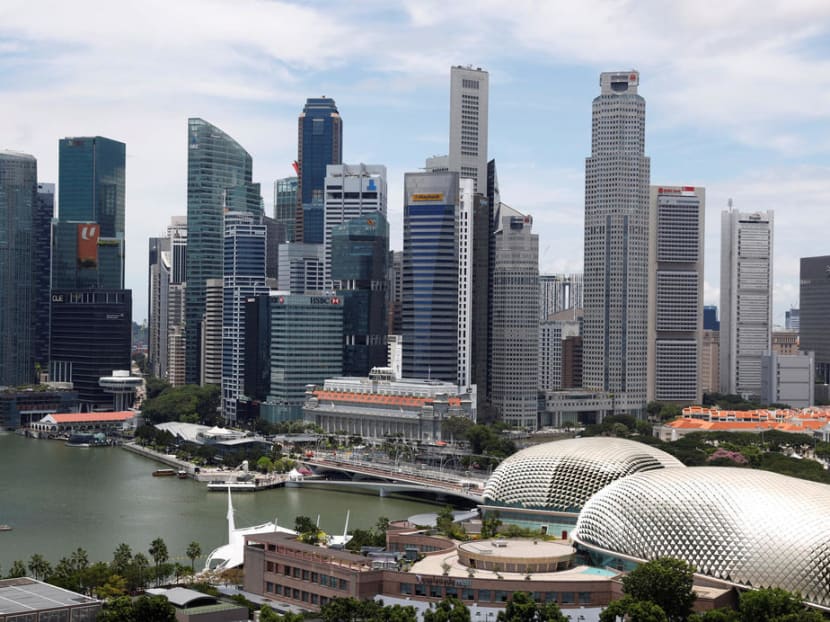Economy still set to expand 6-7% in 2021 before moderating to ‘above-trend’ growth in 2022: MAS
SINGAPORE — Even though Singapore’s economy flatlined in the second and third quarters of this year due to tighter safe distancing measures, it is still set to grow 6 to 7 per cent for the whole of 2021 year-on-year, the Monetary Authority of Singapore (MAS) said.

Overall, Singapore’s economic output returned to its pre-pandemic level in the third quarter of 2021, after a setback in the second quarter.
- Singapore’s economy will grow between 6 and 7 per cent in 2021
- Growth will moderate in 2022 but will still be "above-trend", the central bank said
- The outlook for overseas trade and manufacturing are good, it said
- However, travel and construction will be slower to bounce back
- An economist warns of downside risk in 2022 if China’s economy slows
SINGAPORE — Even though Singapore’s economy flatlined in the second and third quarters of this year due to tighter safe distancing measures, it is still set to grow 6 to 7 per cent for the whole of 2021 year-on-year, the Monetary Authority of Singapore (MAS) said.
This is because there will likely be a gradual relaxation of current Covid-19 measures in the latter half of the current fourth quarter and into next year, even though the economy is being subjected to “fits and starts” due to constant changes in Covid-19 restrictions, the central bank said in its twice-yearly macroeconomic review released on Thursday (Oct 28).
The economy is also expected to expand at a more moderate pace next year, though still above-trend.
MAS did not specify a figure but some economists told TODAY that this likely means the central bank expects growth to come in at 4 per cent or above in 2022 since the medium-term growth trend is between 2 and 4 per cent.
However, senior economist Irvin Seah with DBS bank said that he is slightly more cautious and is forecasting 2022 growth of 3.2 per cent.
This is because Singapore’s economy may be affected by a slowdown in China, he said. The world’s second largest economy has been cracking down on its private sector in recent months, from property to the technology and gaming sectors.
And although Singapore is opening up its economy, the effects of Covid-19 will only be fading away gradually because the authorities have decided to be calibrated in its reopening, he added.
Ms Selena Ling, head of treasury and research at OCBC bank, is a little more bullish and expects growth to come in at between 3 and 5 per cent next year.
ECONOMIC GROWTH
Despite the re-imposition of tighter restrictions this year, MAS said that the pull-back in economic activity was less severe compared with the two-month circuit breaker, which halted almost all economic activities between April and June last year.
“This year’s restrictions were generally less stringent, and firms have adapted to some extent, pivoting to alternative means of doing business in tandem with the changes in public health measures,” It said.
Overall, Singapore’s economic output returned to its pre-pandemic level in the third quarter, after a setback in the second quarter this year.
Growth in domestic-oriented sectors was weak due to heightened alert measures imposed sometime in the second quarter and early in the third quarter. It remains about 10 per cent below the pre-crisis level of output.
Trade-related services rebounded in the third quarter after contracting in the previous quarter, and surpassed pre-pandemic levels by 10 per cent in the third quarter.
"Modern services", covering businesses such as banking, information and communications, was the main driver to overall growth across both quarters. Its output also crossed pre-pandemic levels by 5 per cent in the third quarter.
Travel-related businesses continue to lag behind substantially, with output at only half of pre-Covid levels, MAS said.
OUTLOOK FOR DIFFERENT SECTORS
1. Consumer-facing industries
The recovery of the food-and-beverage (F&B), retail and land transport sector will likely be held back in the early part of the fourth quarter due to the high number of Covid-19 community transmissions and related restrictions.
However, online sales may support these sectors.
In August this year, online transactions accounted for 14 per cent of retail sales and 39 per cent of F&B sales. This is markedly higher than the 7 per cent of retail sales and 10 per cent of F&B sales in the fourth quarter of 2019.
“Consumer confidence is likely to pick up when there is more evidence that the rise in infections is not resulting in higher intensive care unit admissions sufficient to overtax the healthcare system. A more extensive reopening of the economy towards the end of this year should improve footfall for retail businesses and eateries,” MAS said.
2. Travel
The consumer-facing sectors are also affected by lower demand from foreign travellers.
MAS said that travel is not expected to recover quickly or substantially in the near term despite the launching of vaccinated travel lanes to several countries.
The countries covered by that scheme, along with travellers who enter Singapore through the air travel pass, which accepts travellers from China, Hong Kong, Macau and Taiwan, made up 47 per cent of the 1.6 million short-term visitors here on average a month in 2019.
Since the launch of the vaccinated travel lane scheme in September until Oct 25, only about 7,000 vaccinated travel passes have been issued, which accounts for less than 1 per cent of monthly visitor arrivals before the pandemic struck.
“Most tour operators in Singapore remain wary of prematurely scaling up operations and have continued to lean on domestic tourism,” MAS said.
“A stronger rebound in the travel-related sector may only materialise over the course of next year when border barriers are removed more substantially, and a recovery to pre-Covid output level is only anticipated after 2022.”
3. Construction
Higher raw material costs and manpower shortages arising from border restrictions would still be hampering the recovery of the construction sector, MAS said.
In addition, safe management measures at work sites also hinder productivity and disrupt ongoing construction projects, preventing companies from bidding for new contracts.
The easing of some supply-side constraints could allow higher levels of construction activity beyond 2021.
4. Manufacturing
MAS said that the outlook for the manufacturing sector remains bright, due to ongoing strength in the global electronic cycle.
Semiconductor equipment manufacturers in Singapore have invested in new production capacity in anticipation that global demand will remain firm.
5. Modern services
The anticipated pickup in domestic and regional economic activity in the coming quarters should benefit the banks and insurance segments, MAS said.
The outlook is also expected to improve with the vaccinated travel lane arrangements that allows the export of certain segments of professional services, such as business consultancies.
Digitalisation is also expected to support this sector’s growth. For example, payment-processing players are increasingly going online.
6. Trade
Despite the sharp decline in global trade arising from the pandemic, MAS also said that Singapore’s trade in goods was still resilient.
While the trade in goods was about 20 per cent below its average levels in 2019 at its worst in the second quarter of last year, it had returned to pre-pandemic levels in the fourth quarter.
However, the trade in services bore the brunt of the impact. It has not risen substantially from its low activity and was still about 15 per cent below pre-pandemic levels in the second quarter of this year.
This reflects weakness in transport and travel services amid movement and border restrictions, MAS said.
The strong demand for the trade in goods is part of a greater global demand for goods compared to services in the mdist of constraints brought about by the pandemic.
For example, there was demand for electronic goods during lockdowns worldwide and when work-from-home arrangements became the default setting.
“The relatively resilient performance of Singapore’s trade suggests that it has not been materially affected by the disruptions in global and regional supply chains during the pandemic,” MAS said.
Two plausible reasons for this is because Singapore’s manufacturing sector is more concentrated in producing intermediate products, instead of being at the later stage of the supply chain, which is where most production bottlenecks take place.
Singapore’s sources of imports of intermediate goods are also well-diversified, MAS said.








